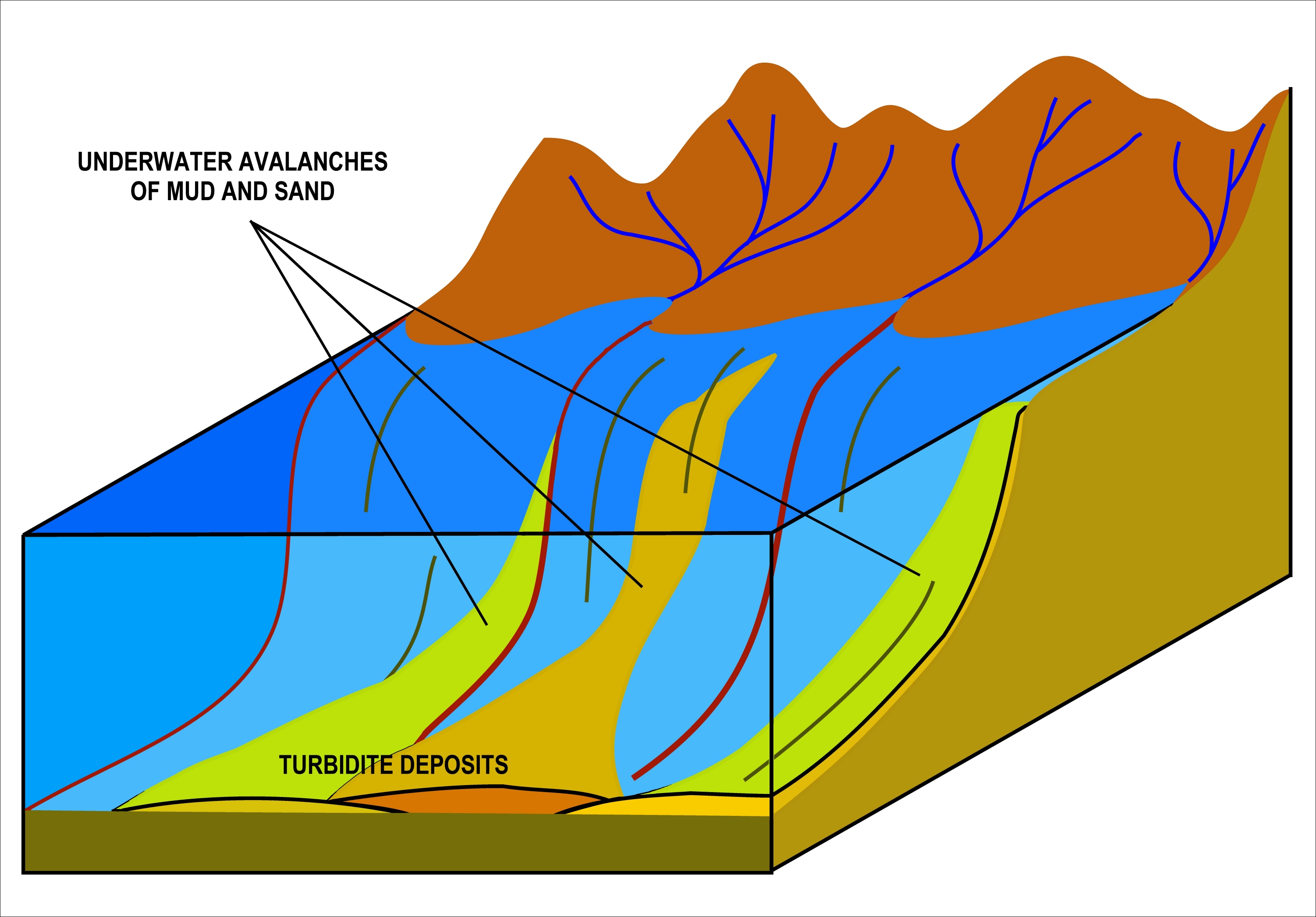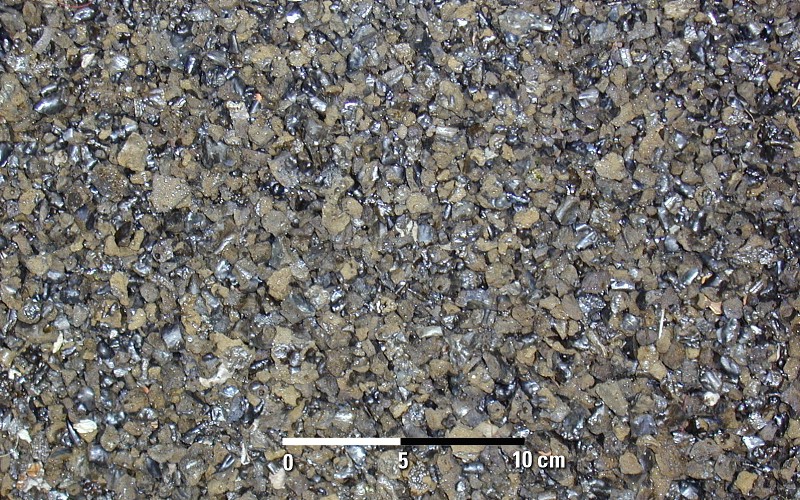|
Longmyndian
The Longmyndian Supergroup is a sequence of Late Precambrian rocks that outcrop between the Pontesford–Linley Fault System and the Church Stretton Fault System in the Welsh Borderland Fault System. The supergroup consists of two major geological groups, the Stretton Group and the overlying Wentnor Group. The rocks are a generally regressive sequence from basinal facies to clastic sedimentation. The rocks are thought to be derived from Uriconian mountains that were formed during the southward subduction of an oceanic plate beneath a continental block (ocean closure). The rocks have since been folded due to fault movements and plunge gently to the south. The Longmyndian rocks were deposited in northeast–southwest trending faulted rift basins. These were deposited on top of the Uriconian volcaniclastic deposits. Subsequent ocean closure squeezed these rocks together to provide sub-vertical bedding in the synclinal sequence we see in exposed rocks today. As noted below, the ... [...More Info...] [...Related Items...] OR: [Wikipedia] [Google] [Baidu] |
Uriconian
Uriconian rocks are volcanic rocks found in parts of Shropshire, United Kingdom. The name relates to '' Uriconio'', the Latin name for an Iron Age hillfort on the summit of the Wrekin, a hill formed of Uriconian rock. The Uriconian rocks of Shropshire ( Wrekin Terrane) are thought to be potentially related to the Longmyndian Supergroup of the Stretton Hills, Shropshire, United Kingdom. Current geological profiling of the terranes suggests that the Uriconian rocks are of Precambrian age (Neoproterozoic Phases 2 and 3).P. J. Brenchley, P. F. Rawson ''The Geology of England and Wales'', 2006, 2nd Ed The Uriconian Rocks outcrop to the southeast of the Long Mynd area of the Welsh Borderland Fault System and beyond the Church Stretton Fault which trends northeast-southwest across the area.W. Compston, A. E. Wright, P. Toghill, ''Dating the Late Precambrian volcanicity of England and Wales, Journal of the Geological Society 2002; v.159; pp 323–339 The Stretton Hills are composed pri ... [...More Info...] [...Related Items...] OR: [Wikipedia] [Google] [Baidu] |
Wentnor Group
The Wentnor Group is a group of rocks associated with the Longmyndian Supergroup of Precambrian age in present-day Wales, U.K. The rocks are located within the confines between the Church Stretton Fault and the Pontesford-Lindley Lineament.P. J. Brenchley, P. F. Rawson ''The Geology of England and Wales'', 2006, 2nd ed. The Wentnor Group is a predominantly sedimentary group with a range of facies attributable to that of a closing ocean.J. N. Carney, J. M. Horak, et al., ''Precambrian Rocks of England and Wales'', ''Joint Nature Conservation Committee.'' Geological Conservation Review Series 20 The Wentnor Group overlies the Stretton Group of rocks and although the units are separate, together they show a good geological progression. At the base of the Stretton Group the rocks are of basinal oceanic facies and as time goes a coarsening occurs with increased terrigenous input from the continent. Turbidites are observed and deltas form latterly with alluvial plains with occasional ... [...More Info...] [...Related Items...] OR: [Wikipedia] [Google] [Baidu] |
Stretton Group
The Stretton Group is a group of rocks associated with the Longmyndian Supergroup of Ediacaran age, in Shropshire, England. The rocks are located within the tract between two elements of the Welsh Borderland Fault System, the Church Stretton Fault and the Pontesford-Linley Lineament.P. J. Brenchley, P. F. Rawson ''The Geology of England and Wales'', 2006, 2nd Ed The Stretton Group is a predominantly sedimentary group with a range of facies attributable to that of a closing ocean.J. N. Carney, J. M. Horak, et al., ''Precambrian Rocks of England and Wales'', ''Joint Nature Conservation Committee.'' Geological Conservation Review Series 20 The Wentnor Group overlies the Stretton Group of rocks and although the units are separate, together they show a good geological progression. At the base of the Stretton Group the rocks are of basinal oceanic facies and as time goes a coarsening occurs with increased terrigenous input from the continent. Turbidites are observed and deltas form lat ... [...More Info...] [...Related Items...] OR: [Wikipedia] [Google] [Baidu] |
Geology Of Shropshire
: ''This article describes the geology of the ceremonial county of Shropshire, England which includes the modern administrative county together with the district of Telford and Wrekin.'' The geology of Shropshire is very diverse with a large number of periods being represented at outcrop. The bedrock consists principally of sedimentary rocks of Palaeozoic and Mesozoic age, surrounding restricted areas of Precambrian metasedimentary and metavolcanic rocks. The county hosts in its Quaternary deposits and landforms, a significant record of recent glaciation. The exploitation of the Coal Measures and other Carboniferous age strata in the Ironbridge area made it one of the birthplaces of the Industrial Revolution. There is also a large amount of mineral wealth in the county, including lead and baryte. Quarrying is still active, with limestone for cement manufacture and concrete aggregate, sandstone, greywacke and dolerite for road aggregate, and sand and gravel for aggregate and d ... [...More Info...] [...Related Items...] OR: [Wikipedia] [Google] [Baidu] |
Long Mynd
, photo = , photo_alt = , photo_caption = View down Townbrook Valley toward Burway Hill , country_type = , country = England , subdivision1_type = County , subdivision1 = Shropshire , borders_on = , biome = Heathland Moorland , topo_map = , topo_maker = , highest = Pole Bank , highest_location = , elevation_m = 516 , elevation_system = , coordinates = , length_km = 11.26 , width_km = 4.8 , area_km2 = 54 , length_orientation= N-S , width_orientation = E-W , length_ref = , width_ref = , area_ref = , parent = , range_coordinates = , range_coordinates_ref= , formed_by = Glaciation , geology = Sandstone , age = Quaternary , orogeny = , map = Shropshire , map_alt = , map_caption = The Long Mynd , m ... [...More Info...] [...Related Items...] OR: [Wikipedia] [Google] [Baidu] |
Geological Unit
A stratigraphic unit is a volume of rock of identifiable origin and relative age range that is defined by the distinctive and dominant, easily mapped and recognizable petrographic, lithologic or paleontologic features (facies) that characterize it. Units must be ''mappable'' and ''distinct'' from one another, but the contact need not be particularly distinct. For instance, a unit may be defined by terms such as "when the sandstone component exceeds 75%". Lithostratigraphic units Sequences of sedimentary and volcanic rocks are subdivided the basis of their shared or associated lithology. Formally identified lithostratigraphic units are structured in a hierarchy of lithostratigraphic rank, higher rank units generally comprising two or more units of lower rank. Going from smaller to larger in rank, the main lithostratigraphic ranks are Bed, Member, Formation, Group and Supergroup. Formal names of lithostratigraphic units are assigned by geological surveys. Units of formation or ... [...More Info...] [...Related Items...] OR: [Wikipedia] [Google] [Baidu] |
Turbidite
A turbidite is the geologic deposit of a turbidity current, which is a type of amalgamation of fluidal and sediment gravity flow responsible for distributing vast amounts of clastic sediment into the deep ocean. Sequencing Turbidites were first properly described by Arnold H. Bouma (1962), who studied deepwater sediments and recognized particular "fining-up intervals" within deep water, fine-grained shales, which were anomalous because they started at pebble conglomerates and terminated in shales. This was anomalous because within the deep ocean it had historically been assumed that there was no mechanism by which tractional flow could carry and deposit coarse-grained sediments into the abyssal depths. Bouma cycles begin with an erosional contact of a coarse lower bed of pebble to granule conglomerate in a sandy matrix, and grade up through coarse then medium plane parallel sandstone; through cross-bedded sandstone; rippled cross-bedded sand/silty sand, and finally la ... [...More Info...] [...Related Items...] OR: [Wikipedia] [Google] [Baidu] |
Batch Volcanics
Batch may refer to: Food and drink * Batch (alcohol), an alcoholic fruit beverage * Batch loaf, a type of bread popular in Ireland * A dialect term for a bread roll used in North Warwickshire, Nuneaton and Coventry, as well as on the Wirral, England * Small batch, bourbon whiskey blended from selected barrels * Wiser's Small Batch, a Canadian whisky made in limited batches by Corby Distillery Ltd, Belleville, Ontario, Canada Manufacturing and technology * Batch distillation, the use of distillation in batches * Batch oven, a furnace used for thermal processing * Batch production, a manufacturing technique * Batch reactor, a type of vessel widely used in the process industries * Fed-batch, a biotechnological batch process * Glass batch calculation, the determination of the correct mix of raw materials for a glass melt * Sequencing batch reactor, an industrial processing tank for the treatment of wastewater * Batching & mixing plants, used in concrete production Computer s ... [...More Info...] [...Related Items...] OR: [Wikipedia] [Google] [Baidu] |
Tuff
Tuff is a type of rock made of volcanic ash ejected from a vent during a volcanic eruption. Following ejection and deposition, the ash is lithified into a solid rock. Rock that contains greater than 75% ash is considered tuff, while rock containing 25% to 75% ash is described as tuffaceous (for example, ''tuffaceous sandstone''). Tuff composed of sandy volcanic material can be referred to as volcanic sandstone. Tuff is a relatively soft rock, so it has been used for construction since ancient times. Because it is common in Italy, the Romans used it often for construction. The Rapa Nui people used it to make most of the '' moai'' statues on Easter Island. Tuff can be classified as either igneous or sedimentary rock. It is usually studied in the context of igneous petrology, although it is sometimes described using sedimentological terms. Tuff is often erroneously called tufa in guidebooks and in television programmes. Volcanic ash The material that is expelled in a ... [...More Info...] [...Related Items...] OR: [Wikipedia] [Google] [Baidu] |
Lapilli
Lapilli is a size classification of tephra, which is material that falls out of the air during a volcanic eruption or during some meteorite impacts. ''Lapilli'' (singular: ''lapillus'') is Latin for "little stones". By definition lapilli range from in diameter. A pyroclastic particle greater than 64 mm in diameter is known as a volcanic bomb when molten, or a volcanic block when solid. Pyroclastic material with particles less than 2 mm in diameter is referred to as volcanic ash. Formation Lapilli are spheroid-, teardrop-, dumbbell- or button-shaped droplets of molten or semi-molten lava ejected from a volcanic eruption that fall to earth while still at least partially molten. These granules are not accretionary, but instead the direct result of liquid rock cooling as it travels through the air. Lapilli tuffs are a very common form of volcanic rock typical of rhyolite, andesite and dacite pyroclastic eruptions, where thick layers of lapilli can be deposited during ... [...More Info...] [...Related Items...] OR: [Wikipedia] [Google] [Baidu] |
Bentonite
Bentonite () is an absorbent swelling clay consisting mostly of montmorillonite (a type of smectite) which can either be Na-montmorillonite or Ca-montmorillonite. Na-montmorillonite has a considerably greater swelling capacity than Ca-montmorillonite. Bentonite usually forms from the weathering of volcanic ash in seawater, or by hydrothermal circulation through the porosity of volcanic ash beds, which converts ( devitrification) the volcanic glass (obsidian, rhyolite, dacite) present in the ash into clay minerals. In the mineral alteration process, a large fraction (up to 40-50 wt.%) of amorphous silica is dissolved and leached away, leaving the bentonite deposit in place. Bentonite beds are white or pale blue or green (traces of reduced ) in fresh exposures, turning to a cream color and then yellow, red, or brown (traces of oxidized ) as the exposure is weathered further. As a swelling clay, bentonite has the ability to absorb large quantities of water, whic ... [...More Info...] [...Related Items...] OR: [Wikipedia] [Google] [Baidu] |




